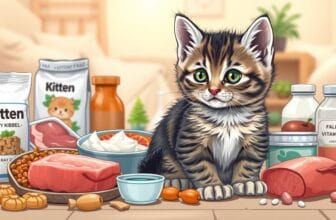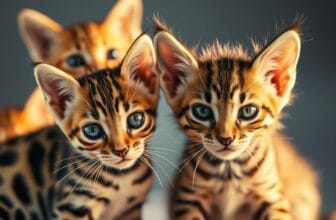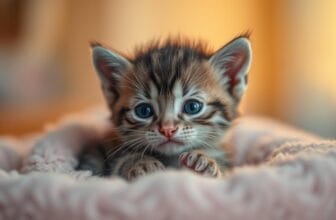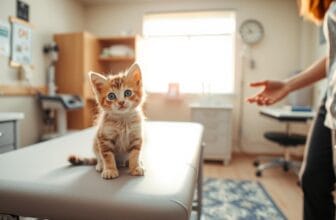
Table of Contents
Ever wondered why some kitten breeds are so charming and unique? Cats have been a part of our lives for thousands of years. Each breed adds its own special magic to our homes.
From the fluffy Maine Coon to the sleek Siamese, there’s a wide range of kitten breeds. Your perfect feline friend might be among these amazing breeds.
This guide will look at the top 10 most loved kitten breeds. We’ll explore their unique traits that make them great companions. Whether you’re new to cats or a seasoned fan, you’ll learn about the special qualities of these adorable animals.
Knowing about these popular kitten breeds can help you choose the right one for you. Let’s explore the amazing world of cats and their unique features!
Understanding Cat Breed Personalities and Characteristics
Exploring the world of cat breeds can help you find the perfect cat for your home. Each breed has its own unique personality traits. These traits go beyond just looks. It’s important to understand these differences when picking a kitten that fits your lifestyle.
Cat personalities are shaped by genetics, environment, and personal experiences. While some breeds have certain traits, remember that every cat is different.
Physical Traits and Temperament Basics
Different cat breeds show amazing variations in temperament and looks. Your future cat might have traits like:
- High energy levels
- Vocal communication preferences
- Social interaction tendencies
- Playfulness
- Independent nature
The Role of Genetics in Breed Development
Genetics play a big role in shaping cat traits. Selective breeding has made cats with specific traits and looks. Some breeds are naturally more inclined to certain behaviors because of their genes.
How to Choose the Right Breed for Your Lifestyle
When picking a kitten, think about these key factors:
- Your living space
- Activity level
- Time for interaction
- Grooming needs
- Compatibility with other pets
Doing thorough research on cat breed personalities will help you make a smart choice. This ensures a happy relationship with your future cat.
The Evolution From Wild Cats to Modern Kitten Breeds
The journey of cat evolution started thousands of years ago. Wild felines first met humans in settlements. Around 10,000 years ago, African wildcats found a new home near early farms in the Fertile Crescent. They were attracted to the rodents that lived in human grain stores.
Domesticating cats was not a plan but a natural bond. These wild cats grew less afraid of humans. They saw the benefits of living near people. Cats helped control pests, and humans gave them food and shelter.
- Early cat domestication started in agricultural regions
- Wildcats self-selected for human interaction
- Natural selection favored less aggressive felines
Today’s kitten breeds are the result of thousands of years of change and breeding. From the Maine Coon to the Siamese, each breed has its own story. They show how humans and cats have interacted over time.
Cats didn’t just become domesticated—they essentially domesticated themselves.
Learning about cat evolution shows how these amazing animals changed from wild hunters to our pets. Their ability to live with humans shows their smartness and flexibility.
Common Physical Characteristics of Popular Kitten Breeds
Exploring kittens means learning about their physical traits. Each breed has its own special features. These traits range from size to coat types, showing how diverse kittens can be.
Size and Weight Variations
Kitten sizes vary a lot. Some are small and compact, while others are big. Here are some typical sizes:
- Tiny breeds: 6-8 inches tall
- Medium breeds: 8-10 inches tall
- Large breeds: 10-12 inches tall
Coat Types and Colors
Cat coats come in many textures and colors. Their facial features often match their coat patterns. This creates a wide range of beautiful looks.
| Coat Type | Characteristics | Common Colors |
|---|---|---|
| Shorthair | Sleek, close-lying fur | Black, white, gray |
| Longhair | Fluffy, extended fur length | Cream, orange, multicolor |
| Rex | Curly, soft texture | Brown, silver, tortoiseshell |
Distinctive Facial Features
Some breeds have unique facial features. They can have round or angular faces. Breed-specific facial characteristics include:
- Flat, compressed faces
- Prominent cheekbones
- Large, expressive eyes
- Distinctive ear shapes
Knowing these traits helps you choose a kitten that fits your style and needs.
Maine Coon: The Gentle Giants of the Cat World
Maine Coon kittens are true gentle giants among large cat breeds. They come from North America’s rugged landscapes. These cats impress with their size and friendly nature.
Maine Coons have unique features that make them stand out. They have:
- Massive body size, often weighing up to 18 pounds
- Long, silky fur with distinctive ear tufts
- Striking facial features with large, expressive eyes
- Bushy, raccoon-like tail
Maine Coons are known for their gentle nature. They are very social and get along well with families and pets.
| Characteristic | Details |
|---|---|
| Average Weight | 10-18 pounds |
| Coat Type | Long, water-resistant |
| Personality | Friendly, playful, intelligent |
| Lifespan | 12-15 years |
Remember, Maine Coon kittens need regular grooming and lots of space. Their playful and dog-like nature makes them special pets.
“The Maine Coon is not just a cat, but a loyal companion with a heart as big as its size.” – Feline Enthusiast Magazine
Siamese Cats: Vocal and Intelligent Companions
Siamese kittens are among the most captivating cats around. They are known for their striking looks and unique personality. Their sleek bodies and piercing blue eyes make them instantly loved by many.
These cats are known for their wide range of sounds. They can “talk” to their owners, showing excitement or frustration. Their voices are a key part of their charm.
Distinctive Color Points and Features
The most noticeable thing about Siamese cats is their color point pattern. Their coat has:
- Cream-colored body with darker colors on ears, face, paws, and tail
- Four main colors: seal, blue, chocolate, and lilac
- Deep blue almond-shaped eyes
- Sleek, muscular body with elegant lines
Social Behavior Patterns
Siamese cats are very social and bond deeply with people. They love to be part of your daily life. They don’t like being alone for long.
Care Requirements
Taking care of Siamese kittens needs commitment and understanding. They need:
- Interactive play sessions
- Puzzle toys
- Regular social interaction
- Consistent training and engagement
They get bored easily because of their high intelligence. Owners must be ready to spend time and energy on them. This keeps them happy and healthy.
Persian Cats: Luxurious and Laid-back Pets

Persian kittens are the ultimate symbol of elegance and calm. These long-haired cats are famous for their unique looks and calm nature. They make great pets for those who want a peaceful companion.
Persian cats have beautiful, flowing fur and cute flat faces. They look very sophisticated. They often have:
- Plush, silky fur that needs daily grooming
- Distinctive round faces with compressed features
- Soft, gentle temperaments
- Preference for quiet, indoor environments
Looking after Persian kittens requires a lot of effort. Their long fur needs daily brushing to keep it looking great. These cats love calm homes where they can relax on soft cushions or snuggle in your lap.
It’s important to know about Persian cats’ health needs. Their face shape can cause breathing and eye problems. Regular vet visits are key to keeping them healthy.
“A Persian cat is not just a pet, but a regal companion that transforms your home into a sanctuary of peace.” – Feline Breed Experts
If you’re looking for a quiet, elegant cat that loves you without needing constant attention, a Persian kitten is perfect.
Bengal Cats: Wild Appearance with Domestic Heart
Bengal kittens are known for their unique look. They have the wild appearance of their ancestors but are loving domestic pets. Their stunning coat patterns and athletic build make them stand out.
These cats are a mix of wild spirit and domestic charm. They come from Asian leopard cats. Bengal cats look wild but are loving family pets.
Unique Spotted Coat Patterns
The coat of Bengal cats is truly special. It has:
- Distinctive rosette markings like leopards
- Many coat colors like brown, silver, and snow
- A soft, plush texture that shines in the light
Every Bengal kitten has its own unique pattern. Their coat shows their wild side and is beautiful.
Exercise and Enrichment Needs
Bengal cats need lots of mental and physical activity. They are very energetic and need play and challenges.
| Activity Type | Recommended Duration | Purpose |
|---|---|---|
| Interactive Play | 30-45 minutes daily | Physical exercise |
| Climbing Structures | Always available | Mental stimulation |
| Puzzle Toys | 15-20 minutes | Cognitive engagement |
Keeping Bengal cats active stops bad behavior. It also lets them use their natural hunting skills.
Ragdoll Cats: The Ultimate Lap Companions
Ragdoll kittens are the ultimate in affectionate cat breeds. They melt hearts with their gentle nature and amazing cuddle skills. These large, beautiful cats are known for relaxing completely when held, earning them the nickname “puppy cats.”
So, what makes Ragdoll cats the best lap cats? They have a few key traits:
- Soft, silky semi-long coat in many colors
- Striking blue eyes that grab your attention
- Calm and patient nature, great for families
- Tendency to go limp when picked up, hence their name “Ragdoll”
Ragdoll cats started in California in the 1960s as pets. They are perfect for homes with kids and other pets because of their gentle nature. Ragdoll kittens grow up to be big, with males reaching up to 20 pounds.
Getting a Ragdoll means you’ll need to groom them often. Their long coat needs weekly brushing to keep it looking good. Despite their size, they love being indoors and enjoy human company and play.
“A Ragdoll doesn’t just sit on your lap; they become a part of your heart.” – Cat Breed Enthusiast
Russian Blue: Elegant and Reserved Felines
Looking for a sophisticated and calm pet? Russian Blue kittens could be just what you need. These cats are known for their stunning looks and quiet nature. They’re perfect for homes that value peace.
Their coat is a standout feature. It’s a thick, short fur that shines in a beautiful silver-blue color. This fur is not just pretty; it also kept them warm in Russia’s cold winters.
Distinctive Coat Characteristics
Russian Blue cats have some amazing coat traits:
- Silvery-blue color that seems to shimmer in different lights
- Short, dense double-coat that sheds less
- Incredibly soft texture, like velvet
- Naturally low-allergen fur, great for those with allergies
Personality Traits and Social Needs
Russian Blue kittens are smart and playful, yet reserved. They bond deeply with their families but also value their independence. They like routine and gentle play.
These cats are perfect for quiet homes, families with kids, or anyone wanting a calm pet. At first, they might seem shy. But once they trust you, they show their loving and playful side.
Understanding Different Kitten Breeds and Their Care Requirements
Choosing the right kitten is more than just loving their cute face. It’s about knowing their breed-specific needs for their health and happiness. Each cat breed has its own special traits that need special care.
When picking a kitten, think about several important things:
- Energy levels and exercise needs
- Grooming needs
- Genetic health issues
- Social needs
Some cats need a lot of grooming, while others are low maintenance. Bengal cats might need more playtime, while Persian cats like it calm. Your lifestyle is key in finding the right kitten for you.
Make a checklist before getting a kitten. Look at your home, work, and energy levels. This ensures you can meet your kitten’s needs.
The right kitten breed turns a pet into a true friend, fitting your life and energy.
Learning about breed-specific needs helps avoid problems. It makes sure you and your kitten will get along well. Vets can give advice that fits your situation.
Health Considerations for Popular Cat Breeds
Knowing about cat health issues is key for pet owners. Different breeds can have genetic disorders that affect their health. Understanding these issues helps you care for your cat better and ensure they live long, healthy lives.
Cat breeds face different health challenges. Some are more likely to get certain diseases that can harm their quality of life.
Common Genetic Health Issues
- Hypertrophic cardiomyopathy (most common heart disease in cats)
- Polycystic kidney disease in Persian cats
- Spinal muscular atrophy in Maine Coon breeds
- Progressive retinal atrophy in Abyssinian cats
Preventive Care Measures
Early health care can lower the risk of genetic disorders in cats. Your vet can create a care plan for your cat’s breed and needs.
- Regular vet visits (recommended twice yearly)
- Genetic screening tests
- Balanced nutrition specific to breed requirements
- Maintaining healthy body weight
- Age-appropriate vaccination schedules
Tip: Early detection through routine screenings can help manage potential health risks and improve your cat’s long-term health outcomes.
Investing in preventive care is always more cost-effective than treating advanced medical conditions.
Grooming Needs Across Different Breeds

Cat grooming is key to pet care and changes with each kitten breed. The type and length of your cat’s coat decide its grooming needs. Short-haired cats need less grooming than long-haired ones.
Knowing what grooming your cat needs keeps it healthy and looking good. Each cat breed has its own coat type that needs special care:
- Long-haired breeds like Persian cats need daily brushing
- Short-haired breeds need weekly coat maintenance
- Some breeds have special coat textures needing specialized care
When grooming your cat, remember these important points:
- Brush frequency based on coat type
- Use the right grooming tools
- Check for skin conditions during grooming sessions
- Trim nails regularly
Professional groomers say knowing your breed’s grooming needs is vital. It prevents matting, reduces shedding, and keeps skin healthy.
Proper grooming is not just about appearance—it’s a critical component of your cat’s overall wellness.
Exercise and Enrichment Requirements
It’s key to know what your kitten needs for exercise and fun. Each cat breed is different, needing special ways to play and stay active.
Kitten exercise is more than just moving around. It’s about keeping their mind sharp and engaging with their surroundings. This helps them stay healthy and joyful.
Activity Levels by Breed
Cats vary a lot in how much energy they have and what they like to do. Some kittens need lots of playtime every day. Others are happy with less.
- High-energy breeds: Bengal, Abyssinian, Oriental Shorthair
- Moderate-activity breeds: American Shorthair, Maine Coon
- Low-energy breeds: Persian, Russian Blue
Recommended Toys and Activities
Choosing the right toys can make a big difference in your kitten’s day. It keeps them from getting bored.
| Breed Energy Level | Recommended Toys | Daily Play Duration |
|---|---|---|
| High-Energy | Interactive wand toys, puzzle feeders, climbing trees | 30-45 minutes |
| Moderate-Energy | Laser pointers, crinkle balls, scratching posts | 20-30 minutes |
| Low-Energy | Soft plush toys, gentle interactive games | 10-15 minutes |
Keep in mind, every kitten is unique. Watch what they like and change their playtime to fit their needs.
Socialization and Training Tips for Kittens
Kitten socialization is key to their future behavior and personality. The first few weeks are vital for positive behavior and strong bonds with humans. Good training makes your kitten a well-adjusted adult cat.
Begin socializing your kitten between 2-7 weeks old. This is when they learn and adapt best. Here are some tips for effective kitten socialization:
- Expose your kitten to various people, sounds, and environments
- Use positive reinforcement during training sessions
- Create calm, gentle interactions with new experiences
- Introduce other pets gradually and supervise interactions
Training a kitten needs patience. Use treats and gentle praise for good behavior. Start litter box training right away, after meals and naps. Stop unwanted behaviors by redirecting and providing the right toys.
“Consistent, gentle training builds trust and helps kittens develop confidence.” – Veterinary Behavioral Specialists
Different breeds need different socialization approaches. Some cats are more social, while others need more time. Knowing your kitten’s personality helps tailor the best training.
- Always use soft voices and slow movements
- Avoid punishment-based training methods
- Make training sessions short and enjoyable
Every kitten is unique. Watch how they react and adjust your training. With love and effort, your kitten will grow into a confident, well-behaved friend.
Making the Right Choice for Your Home

Choosing the right kitten for your home is a big decision. You need to think about your lifestyle, living space, and what you like. This ensures you find the perfect kitten for your family.
Choosing a kitten isn’t just about their looks. You must consider important factors like:
- Available living space
- Family composition
- Time for pet care and interaction
- Grooming requirements
- Energy levels
Adopting a kitten can be a great way to find your new pet. Shelters and rescue groups have many kittens, both purebred and mixed-breed. Each cat has a unique personality waiting to connect with the right family.
Here are some tips for choosing the right kitten:
- Research breed characteristics thoroughly
- Visit potential kittens in person
- Assess the kitten’s temperament
- Consider long-term care commitments
- Prepare your home for a new pet
The right kitten will fit right into your home. They will bring joy, companionship, and love. Take your time, ask questions, and trust your instincts when choosing.
Conclusion
Exploring kitten breed diversity opens up a world of unique personalities and traits. It’s more than just picking a pet; it’s about forming a deep bond. This bond enriches both your life and your new pet’s.
Being a responsible pet owner means knowing what you’re getting into. Each breed has its own special qualities that fit different lifestyles. Whether you like the playful Bengal, the elegant Russian Blue, or the gentle Maine Coon, knowing their needs is key to a happy relationship.
Choosing a kitten is a big decision that requires thought and love. It’s not just about picking a pet; it’s about starting a new chapter in your life. Every cat is special, with their own personality that goes beyond breed stereotypes.
By learning about each breed’s needs and health, you’ll build a strong bond with your new pet. The right kitten is more than a pet; they’re a loving family member. They’ll bring joy and endless fun to your home.
FAQ
What are the most popular kitten breeds?
Popular kitten breeds include Maine Coon, Siamese, Persian, Bengal, Ragdoll, and Russian Blue. Each has its own unique traits and personalities. This makes them appealing to different cat owners.
How do I choose the right kitten breed for my lifestyle?
Think about your living space, time for care, energy levels, and what you like. Ragdolls are great for families, while Bengals suit active owners. Look at each breed’s needs for exercise, grooming, and social interaction to find the best fit.
What are common health considerations for different cat breeds?
Each breed faces specific health risks. Persians might have breathing problems due to their faces, while Maine Coons can get hip dysplasia. Regular vet visits, preventive care, and knowing breed-specific health issues are key to your kitten’s health.
How much grooming do different kitten breeds require?
Grooming needs vary by breed. Long-haired breeds like Persians need daily brushing and often professional grooming. Short-haired breeds like Russian Blues require less. Maine Coons have thick coats that need regular grooming to prevent matting.
Are some cat breeds better for people with allergies?
Breeds like Russian Blue and Siberian are considered hypoallergenic. They have lower levels of allergens. But, no breed is completely allergen-free. Grooming, air purification, and talking to an allergist can help manage allergies.
How important is early socialization for kittens?
Early socialization is vital for kittens to grow into well-adjusted cats. Introduce them to people, sounds, and experiences between 2-7 weeks. This helps them become confident and adaptable. Different breeds may react differently, so understanding your breed’s temperament is important.
What are the exercise needs for different kitten breeds?
Exercise needs vary. Bengal and Siamese cats need lots of playtime and mental stimulation. Persian and Ragdoll breeds are more laid-back and need less activity. Interactive toys and regular play are essential for all breeds.
How do I train a kitten effectively?
Effective kitten training needs patience, consistency, and positive reinforcement. Start with basic training, use rewards, and adapt to your breed’s personality. Some breeds, like Siamese, learn quickly, while others need more gentle training.
What should I consider before adopting a purebred kitten?
Research the breed’s characteristics, health issues, care needs, and financial commitment. Consider adoption from reputable breeders or rescue organizations. Think about your living situation, time for care, and if you match the breed’s personality and energy levels.
How do I ensure my kitten stays healthy?
Feed a balanced diet, schedule regular vet visits, and keep up with vaccinations and parasite prevention. Each breed has unique health needs. Maintain a consistent care routine and watch for any health or behavior changes.







